engine RENAULT KANGOO 2013 X61 / 2.G Diesel DCM 1.2 Injection Workshop Manual
[x] Cancel search | Manufacturer: RENAULT, Model Year: 2013, Model line: KANGOO, Model: RENAULT KANGOO 2013 X61 / 2.GPages: 204, PDF Size: 0.99 MB
Page 1 of 204
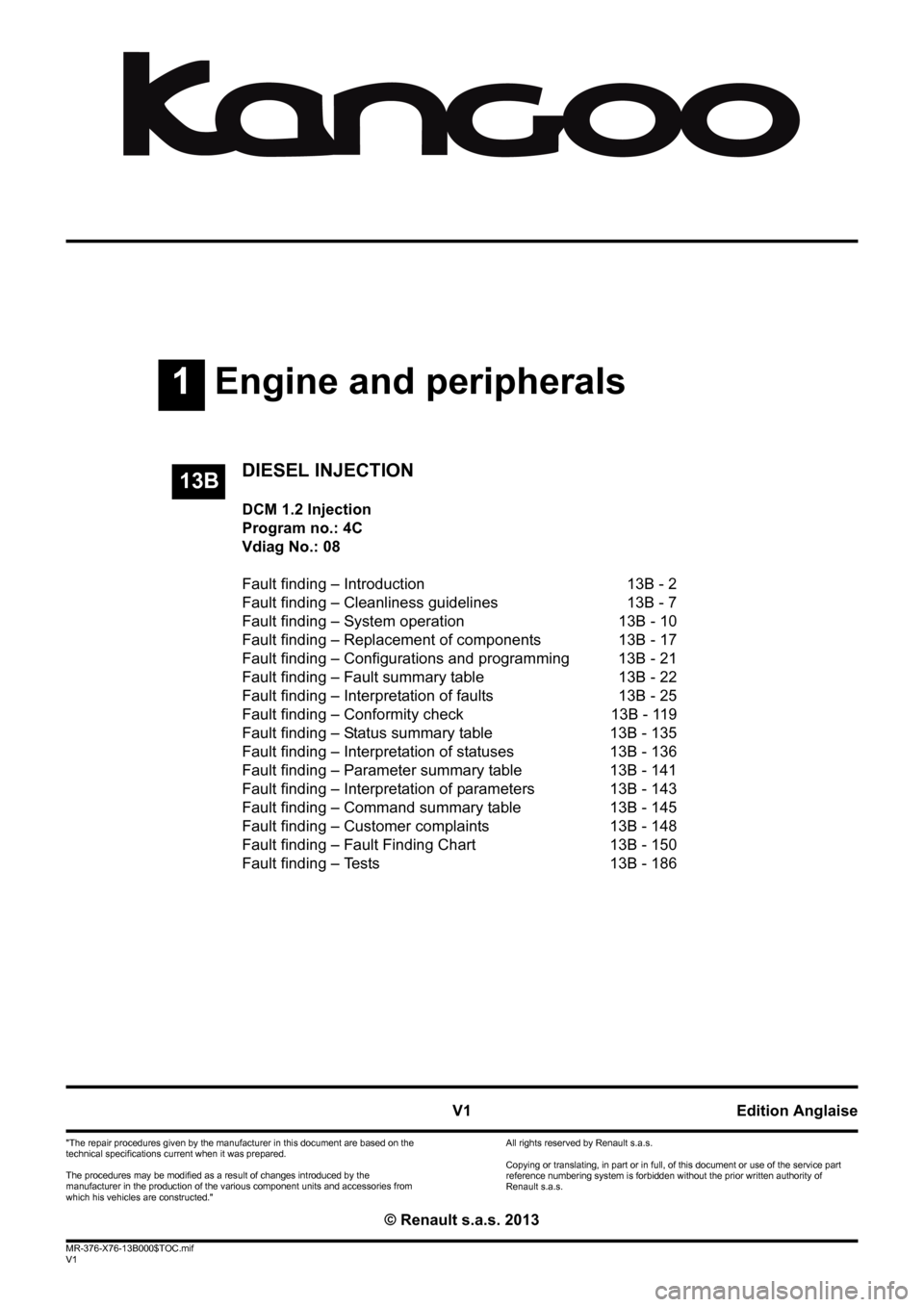
1Engine and peripherals
V1 MR-376-X76-13B000$TOC.mif
V1
13B
"The repair procedures given by the manufacturer in this document are based on the
technical specifications current when it was prepared.
The procedures may be modified as a result of changes introduced by the
manufacturer in the production of the various component units and accessories from
which his vehicles are constructed."
V1
All rights reserved by Renault s.a.s.
Edition Anglaise
Copying or translating, in part or in full, of this document or use of the service part
reference numbering system is forbidden without the prior written authority of
Renault s.a.s.
© Renault s.a.s. 2013
DIESEL INJECTION
DCM 1.2 Injection
Program no.: 4C
Vdiag No.: 08
Fault finding – Introduction 13B - 2
Fault finding – Cleanliness guidelines 13B - 7
Fault finding – System operation 13B - 10
Fault finding – Replacement of components 13B - 17
Fault finding – Configurations and programming 13B - 21
Fault finding – Fault summary table 13B - 22
Fault finding – Interpretation of faults 13B - 25
Fault finding – Conformity check 13B - 119
Fault finding – Status summary table 13B - 135
Fault finding – Interpretation of statuses 13B - 136
Fault finding – Parameter summary table 13B - 141
Fault finding – Interpretation of parameters 13B - 143
Fault finding – Command summary table 13B - 145
Fault finding – Customer complaints 13B - 148
Fault finding – Fault Finding Chart 13B - 150
Fault finding – Tests 13B - 186
Page 2 of 204
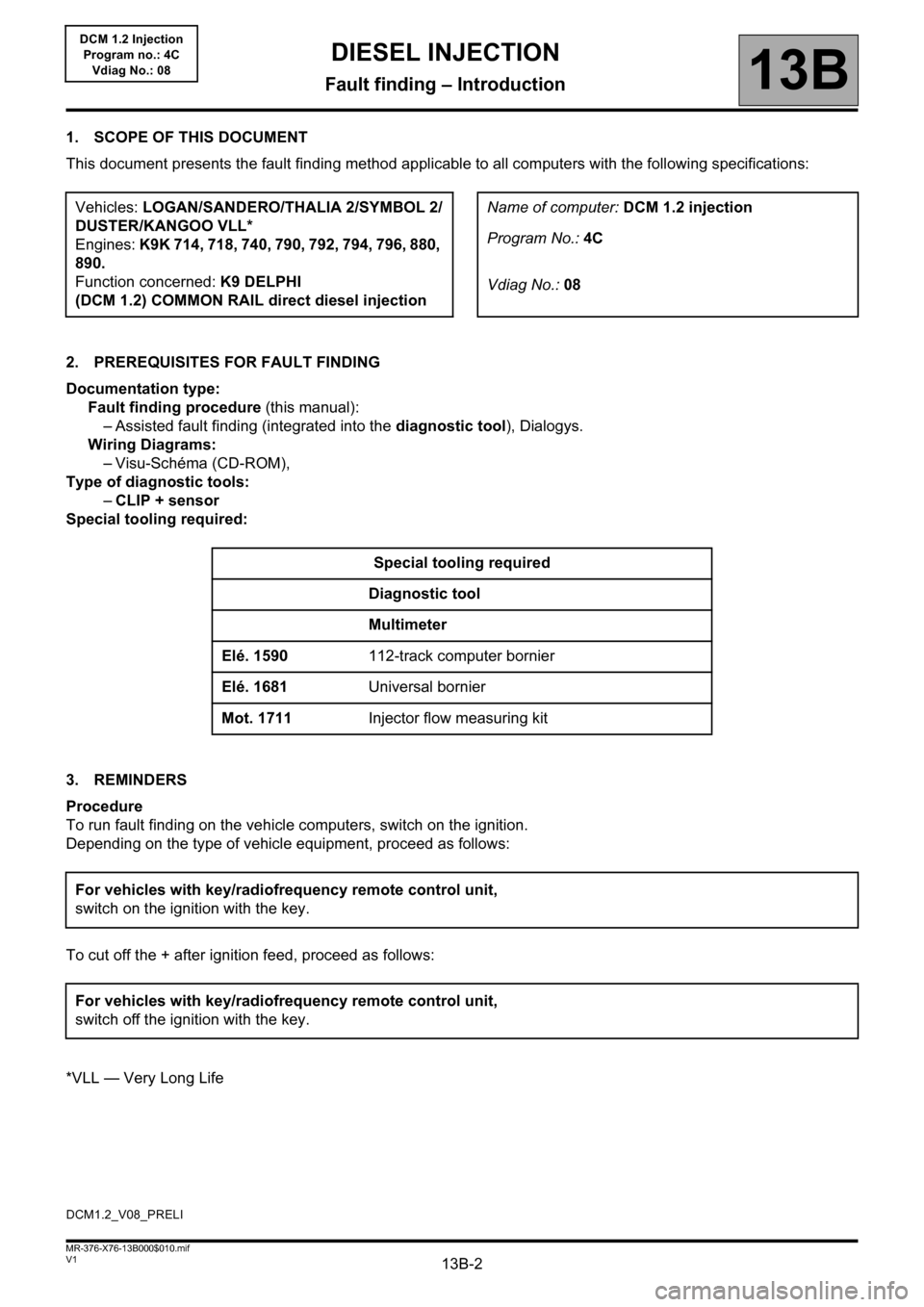
13B-2V1 MR-376-X76-13B000$010.mif
13B
DCM 1.2 Injection
Program no.: 4C
Vdiag No.: 08
1. SCOPE OF THIS DOCUMENT
This document presents the fault finding method applicable to all computers with the following specifications:
2. PREREQUISITES FOR FAULT FINDING
Documentation type:
Fault finding procedure (this manual):
– Assisted fault finding (integrated into the diagnostic tool), Dialogys.
Wiring Diagrams:
– Visu-Schéma (CD-ROM),
Type of diagnostic tools:
–CLIP + sensor
Special tooling required:
3. REMINDERS
Procedure
To run fault finding on the vehicle computers, switch on the ignition.
Depending on the type of vehicle equipment, proceed as follows:
To cut off the + after ignition feed, proceed as follows:
*VLL — Very Long LifeVehicles: LOGAN/SANDERO/THALIA 2/SYMBOL 2/
DUSTER/KANGOO VLL*
Engines: K9K 714, 718, 740, 790, 792, 794, 796, 880,
890.
Function concerned: K9 DELPHI
(DCM 1.2) COMMON RAIL direct diesel injectionName of computer: DCM 1.2 injection
Program No.: 4C
Vdiag No.: 08
Special tooling required
Diagnostic tool
Multimeter
Elé. 1590112-track computer bornier
Elé. 1681Universal bornier
Mot. 1711Injector flow measuring kit
For vehicles with key/radiofrequency remote control unit,
switch on the ignition with the key.
For vehicles with key/radiofrequency remote control unit,
switch off the ignition with the key.
DCM1.2_V08_PRELI
DIESEL INJECTION
Fault finding – Introduction
Page 7 of 204
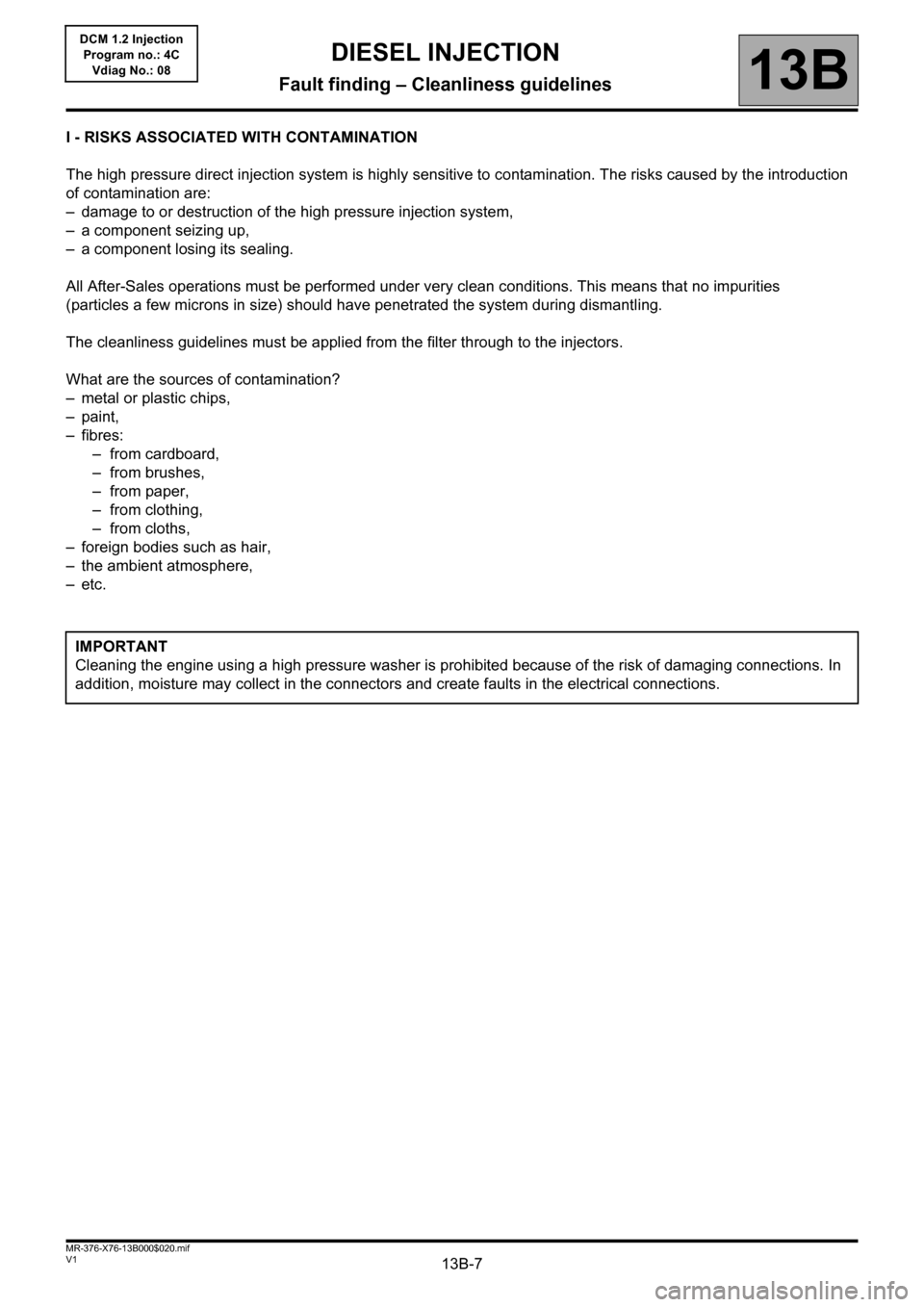
13B-7V1 MR-376-X76-13B000$020.mif
13B
DCM 1.2 Injection
Program no.: 4C
Vdiag No.: 08
I - RISKS ASSOCIATED WITH CONTAMINATION
The high pressure direct injection system is highly sensitive to contamination. The risks caused by the introduction
of contamination are:
– damage to or destruction of the high pressure injection system,
– a component seizing up,
– a component losing its sealing.
All After-Sales operations must be performed under very clean conditions. This means that no impurities
(particles a few microns in size) should have penetrated the system during dismantling.
The cleanliness guidelines must be applied from the filter through to the injectors.
What are the sources of contamination?
– metal or plastic chips,
– paint,
–fibres:
– from cardboard,
– from brushes,
– from paper,
– from clothing,
–from cloths,
– foreign bodies such as hair,
– the ambient atmosphere,
–etc.
IMPORTANT
Cleaning the engine using a high pressure washer is prohibited because of the risk of damaging connections. In
addition, moisture may collect in the connectors and create faults in the electrical connections.
DIESEL INJECTION
Fault finding – Cleanliness guidelines
Page 10 of 204
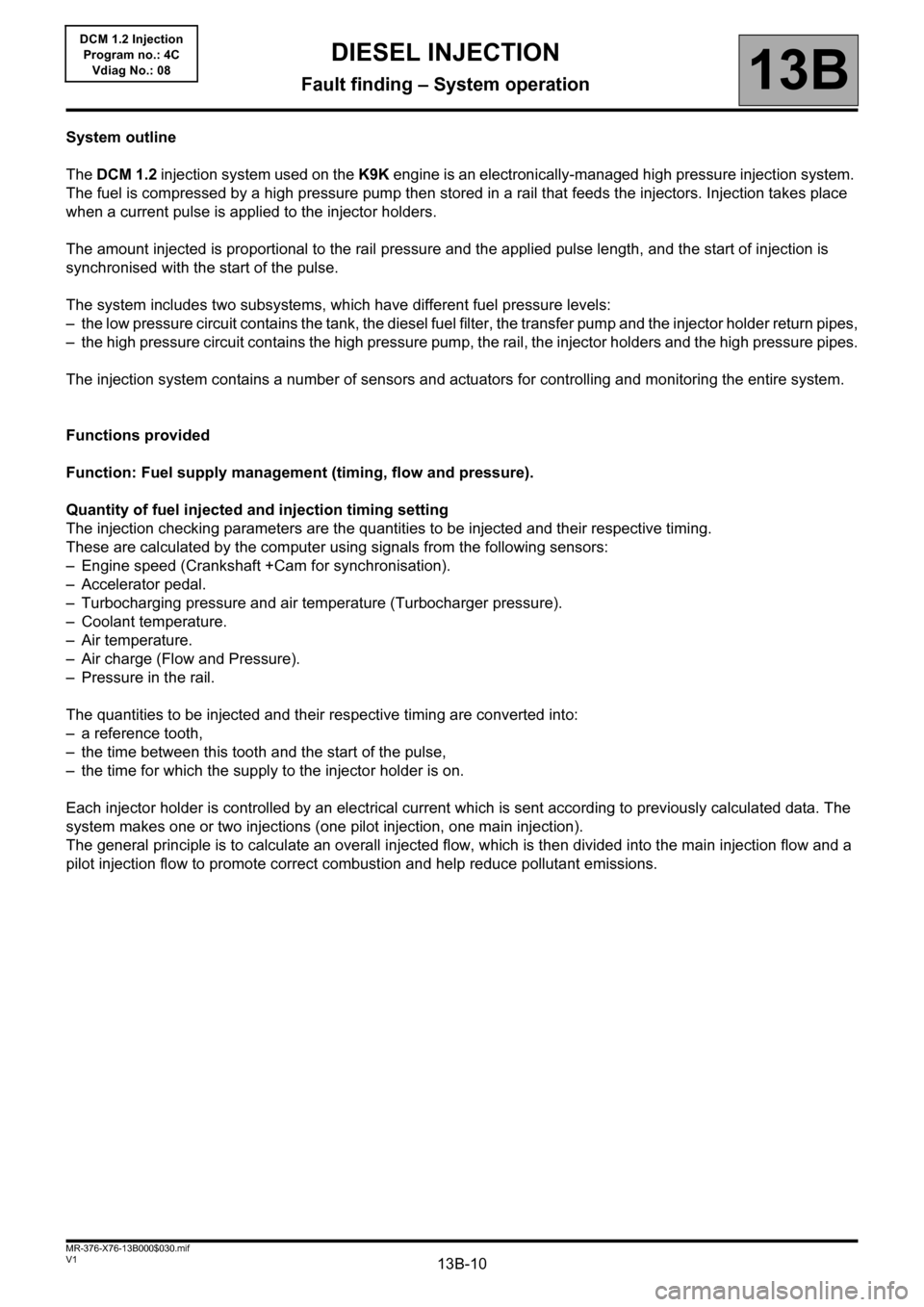
13B-10V1 MR-376-X76-13B000$030.mif
13B
DCM 1.2 Injection
Program no.: 4C
Vdiag No.: 08
System outline
The DCM 1.2 injection system used on the K9K engine is an electronically-managed high pressure injection system.
The fuel is compressed by a high pressure pump then stored in a rail that feeds the injectors. Injection takes place
when a current pulse is applied to the injector holders.
The amount injected is proportional to the rail pressure and the applied pulse length, and the start of injection is
synchronised with the start of the pulse.
The system includes two subsystems, which have different fuel pressure levels:
– the low pressure circuit contains the tank, the diesel fuel filter, the transfer pump and the injector holder return pipes,
– the high pressure circuit contains the high pressure pump, the rail, the injector holders and the high pressure pipes.
The injection system contains a number of sensors and actuators for controlling and monitoring the entire system.
Functions provided
Function: Fuel supply management (timing, flow and pressure).
Quantity of fuel injected and injection timing setting
The injection checking parameters are the quantities to be injected and their respective timing.
These are calculated by the computer using signals from the following sensors:
– Engine speed (Crankshaft +Cam for synchronisation).
– Accelerator pedal.
– Turbocharging pressure and air temperature (Turbocharger pressure).
– Coolant temperature.
– Air temperature.
– Air charge (Flow and Pressure).
– Pressure in the rail.
The quantities to be injected and their respective timing are converted into:
– a reference tooth,
– the time between this tooth and the start of the pulse,
– the time for which the supply to the injector holder is on.
Each injector holder is controlled by an electrical current which is sent according to previously calculated data. The
system makes one or two injections (one pilot injection, one main injection).
The general principle is to calculate an overall injected flow, which is then divided into the main injection flow and a
pilot injection flow to promote correct combustion and help reduce pollutant emissions.
DIESEL INJECTION
Fault finding – System operation
Page 11 of 204
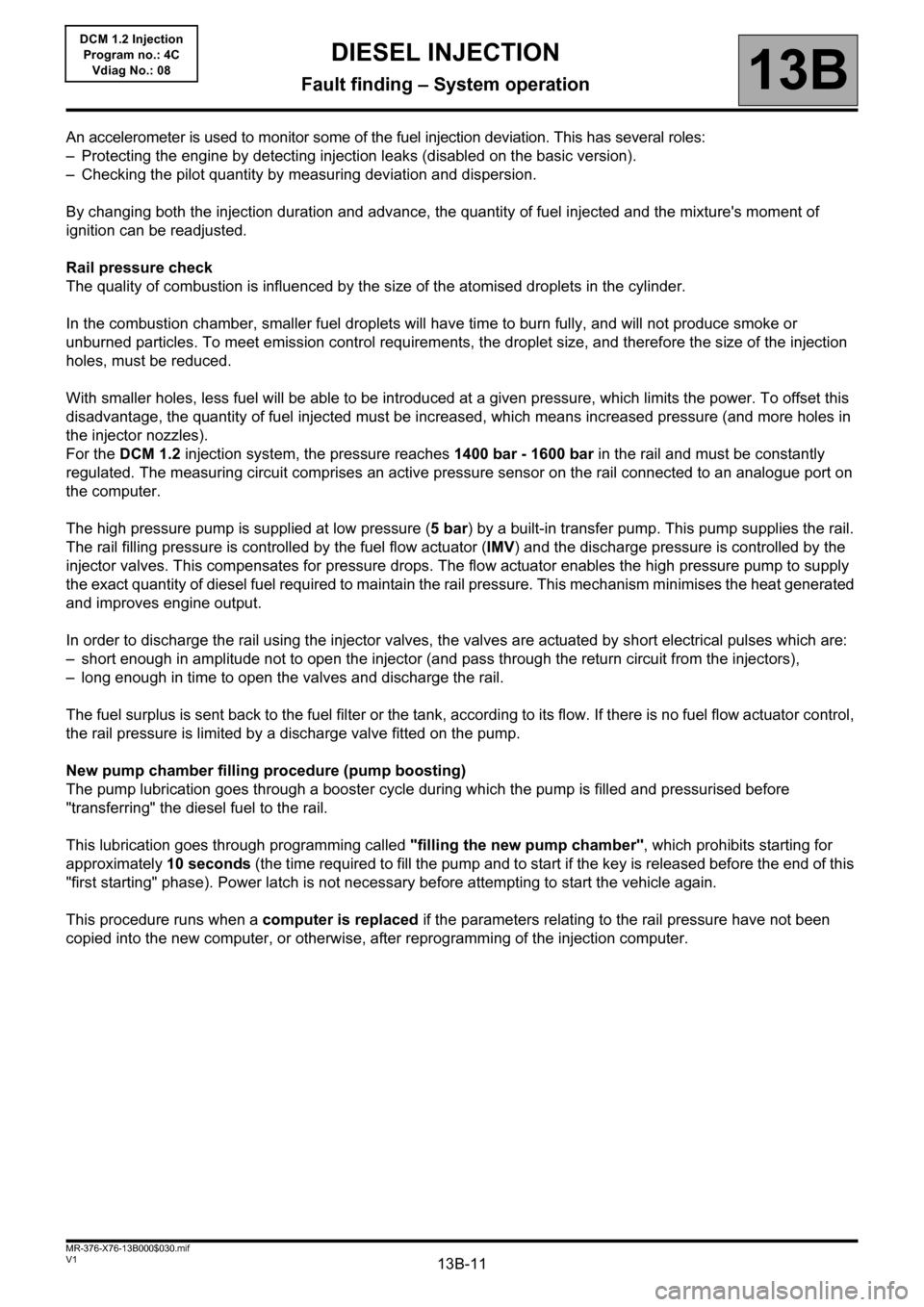
13B-11V1 MR-376-X76-13B000$030.mif
DIESEL INJECTION
Fault finding – System operation13B
DCM 1.2 Injection
Program no.: 4C
Vdiag No.: 08
An accelerometer is used to monitor some of the fuel injection deviation. This has several roles:
– Protecting the engine by detecting injection leaks (disabled on the basic version).
– Checking the pilot quantity by measuring deviation and dispersion.
By changing both the injection duration and advance, the quantity of fuel injected and the mixture's moment of
ignition can be readjusted.
Rail pressure check
The quality of combustion is influenced by the size of the atomised droplets in the cylinder.
In the combustion chamber, smaller fuel droplets will have time to burn fully, and will not produce smoke or
unburned particles. To meet emission control requirements, the droplet size, and therefore the size of the injection
holes, must be reduced.
With smaller holes, less fuel will be able to be introduced at a given pressure, which limits the power. To offset this
disadvantage, the quantity of fuel injected must be increased, which means increased pressure (and more holes in
the injector nozzles).
For the DCM 1.2 injection system, the pressure reaches 1400 bar - 1600 bar in the rail and must be constantly
regulated. The measuring circuit comprises an active pressure sensor on the rail connected to an analogue port on
the computer.
The high pressure pump is supplied at low pressure (5bar) by a built-in transfer pump. This pump supplies the rail.
The rail filling pressure is controlled by the fuel flow actuator (IMV) and the discharge pressure is controlled by the
injector valves. This compensates for pressure drops. The flow actuator enables the high pressure pump to supply
the exact quantity of diesel fuel required to maintain the rail pressure. This mechanism minimises the heat generated
and improves engine output.
In order to discharge the rail using the injector valves, the valves are actuated by short electrical pulses which are:
– short enough in amplitude not to open the injector (and pass through the return circuit from the injectors),
– long enough in time to open the valves and discharge the rail.
The fuel surplus is sent back to the fuel filter or the tank, according to its flow. If there is no fuel flow actuator control,
the rail pressure is limited by a discharge valve fitted on the pump.
New pump chamber filling procedure (pump boosting)
The pump lubrication goes through a booster cycle during which the pump is filled and pressurised before
"transferring" the diesel fuel to the rail.
This lubrication goes through programming called "filling the new pump chamber", which prohibits starting for
approximately 10 seconds (the time required to fill the pump and to start if the key is released before the end of this
"first starting" phase). Power latch is not necessary before attempting to start the vehicle again.
This procedure runs when a computer is replaced if the parameters relating to the rail pressure have not been
copied into the new computer, or otherwise, after reprogramming of the injection computer.
Page 12 of 204
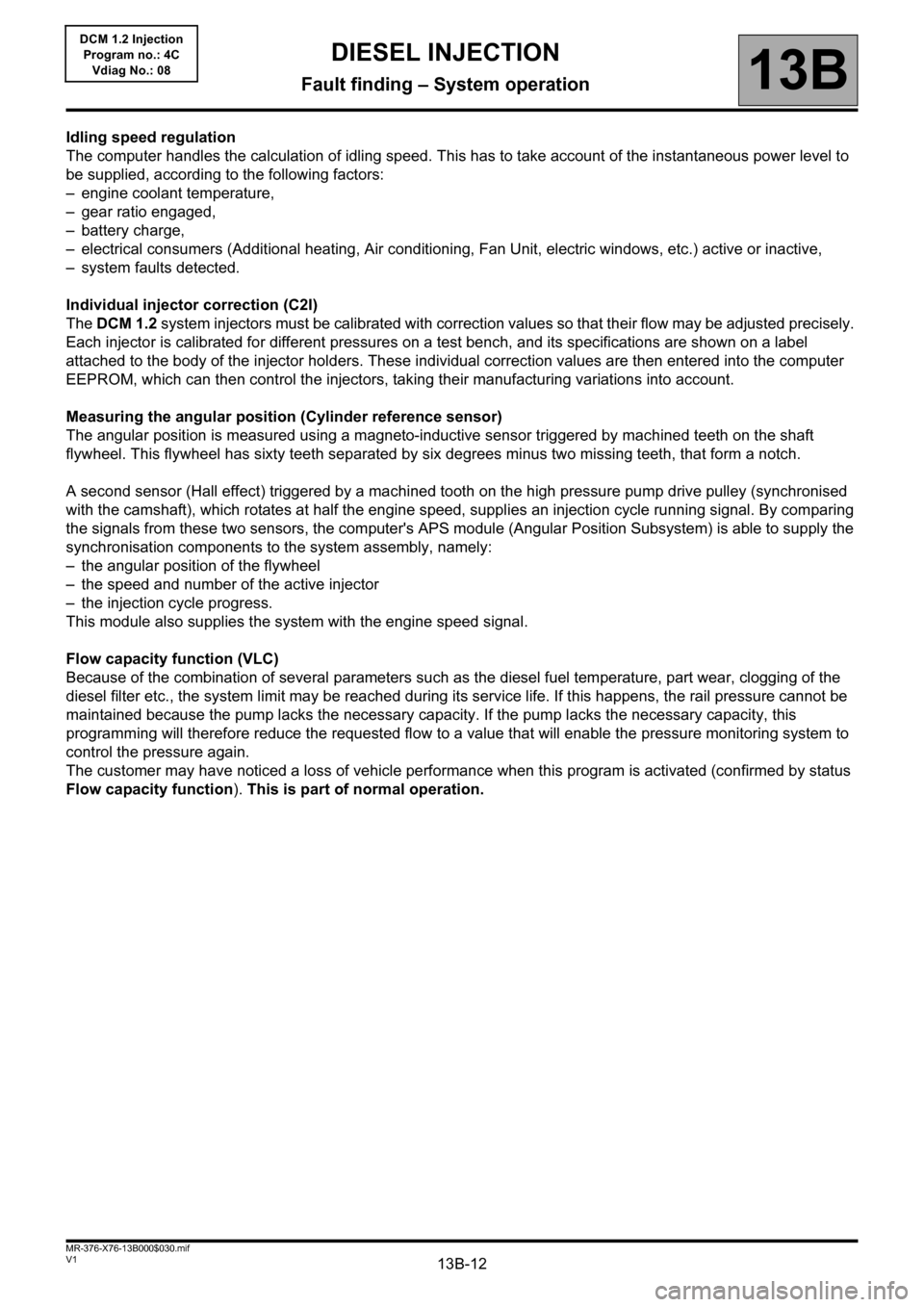
13B-12V1 MR-376-X76-13B000$030.mif
DIESEL INJECTION
Fault finding – System operation13B
DCM 1.2 Injection
Program no.: 4C
Vdiag No.: 08
Idling speed regulation
The computer handles the calculation of idling speed. This has to take account of the instantaneous power level to
be supplied, according to the following factors:
– engine coolant temperature,
– gear ratio engaged,
– battery charge,
– electrical consumers (Additional heating, Air conditioning, Fan Unit, electric windows, etc.) active or inactive,
– system faults detected.
Individual injector correction (C2I)
The DCM 1.2 system injectors must be calibrated with correction values so that their flow may be adjusted precisely.
Each injector is calibrated for different pressures on a test bench, and its specifications are shown on a label
attached to the body of the injector holders. These individual correction values are then entered into the computer
EEPROM, which can then control the injectors, taking their manufacturing variations into account.
Measuring the angular position (Cylinder reference sensor)
The angular position is measured using a magneto-inductive sensor triggered by machined teeth on the shaft
flywheel. This flywheel has sixty teeth separated by six degrees minus two missing teeth, that form a notch.
A second sensor (Hall effect) triggered by a machined tooth on the high pressure pump drive pulley (synchronised
with the camshaft), which rotates at half the engine speed, supplies an injection cycle running signal. By comparing
the signals from these two sensors, the computer's APS module (Angular Position Subsystem) is able to supply the
synchronisation components to the system assembly, namely:
– the angular position of the flywheel
– the speed and number of the active injector
– the injection cycle progress.
This module also supplies the system with the engine speed signal.
Flow capacity function (VLC)
Because of the combination of several parameters such as the diesel fuel temperature, part wear, clogging of the
diesel filter etc., the system limit may be reached during its service life. If this happens, the rail pressure cannot be
maintained because the pump lacks the necessary capacity. If the pump lacks the necessary capacity, this
programming will therefore reduce the requested flow to a value that will enable the pressure monitoring system to
control the pressure again.
The customer may have noticed a loss of vehicle performance when this program is activated (confirmed by status
Flow capacity function). This is part of normal operation.
Page 13 of 204
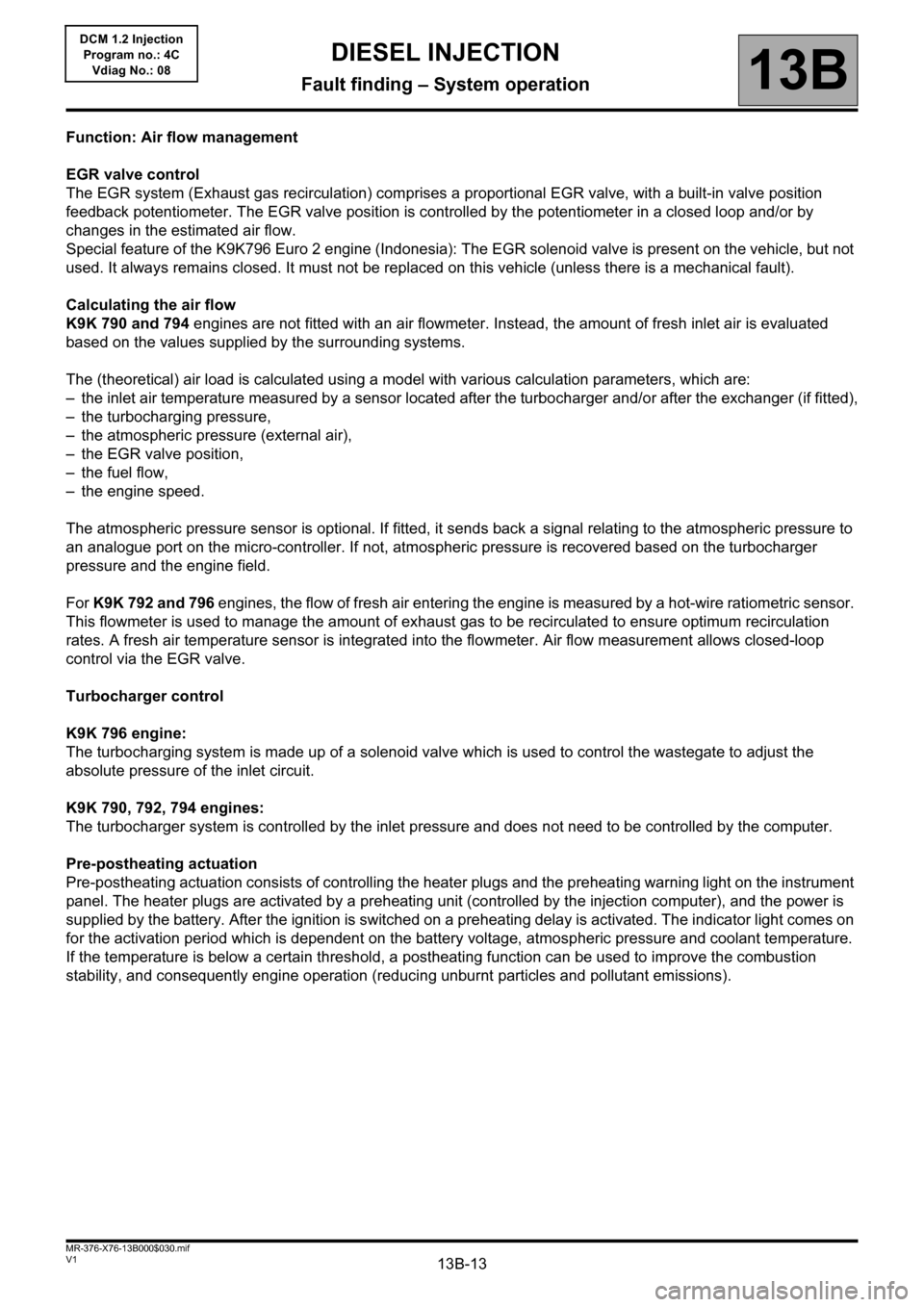
13B-13V1 MR-376-X76-13B000$030.mif
DIESEL INJECTION
Fault finding – System operation13B
DCM 1.2 Injection
Program no.: 4C
Vdiag No.: 08
Function: Air flow management
EGR valve control
The EGR system (Exhaust gas recirculation) comprises a proportional EGR valve, with a built-in valve position
feedback potentiometer. The EGR valve position is controlled by the potentiometer in a closed loop and/or by
changes in the estimated air flow.
Special feature of the K9K796 Euro 2 engine (Indonesia): The EGR solenoid valve is present on the vehicle, but not
used. It always remains closed. It must not be replaced on this vehicle (unless there is a mechanical fault).
Calculating the air flow
K9K 790 and 794 engines are not fitted with an air flowmeter. Instead, the amount of fresh inlet air is evaluated
based on the values supplied by the surrounding systems.
The (theoretical) air load is calculated using a model with various calculation parameters, which are:
– the inlet air temperature measured by a sensor located after the turbocharger and/or after the exchanger (if fitted),
– the turbocharging pressure,
– the atmospheric pressure (external air),
– the EGR valve position,
– the fuel flow,
– the engine speed.
The atmospheric pressure sensor is optional. If fitted, it sends back a signal relating to the atmospheric pressure to
an analogue port on the micro-controller. If not, atmospheric pressure is recovered based on the turbocharger
pressure and the engine field.
For K9K 792 and 796 engines, the flow of fresh air entering the engine is measured by a hot-wire ratiometric sensor.
This flowmeter is used to manage the amount of exhaust gas to be recirculated to ensure optimum recirculation
rates. A fresh air temperature sensor is integrated into the flowmeter. Air flow measurement allows closed-loop
control via the EGR valve.
Turbocharger control
K9K 796 engine:
The turbocharging system is made up of a solenoid valve which is used to control the wastegate to adjust the
absolute pressure of the inlet circuit.
K9K 790, 792, 794 engines:
The turbocharger system is controlled by the inlet pressure and does not need to be controlled by the computer.
Pre-postheating actuation
Pre-postheating actuation consists of controlling the heater plugs and the preheating warning light on the instrument
panel. The heater plugs are activated by a preheating unit (controlled by the injection computer), and the power is
supplied by the battery. After the ignition is switched on a preheating delay is activated. The indicator light comes on
for the activation period which is dependent on the battery voltage, atmospheric pressure and coolant temperature.
If the temperature is below a certain threshold, a postheating function can be used to improve the combustion
stability, and consequently engine operation (reducing unburnt particles and pollutant emissions).
Page 14 of 204
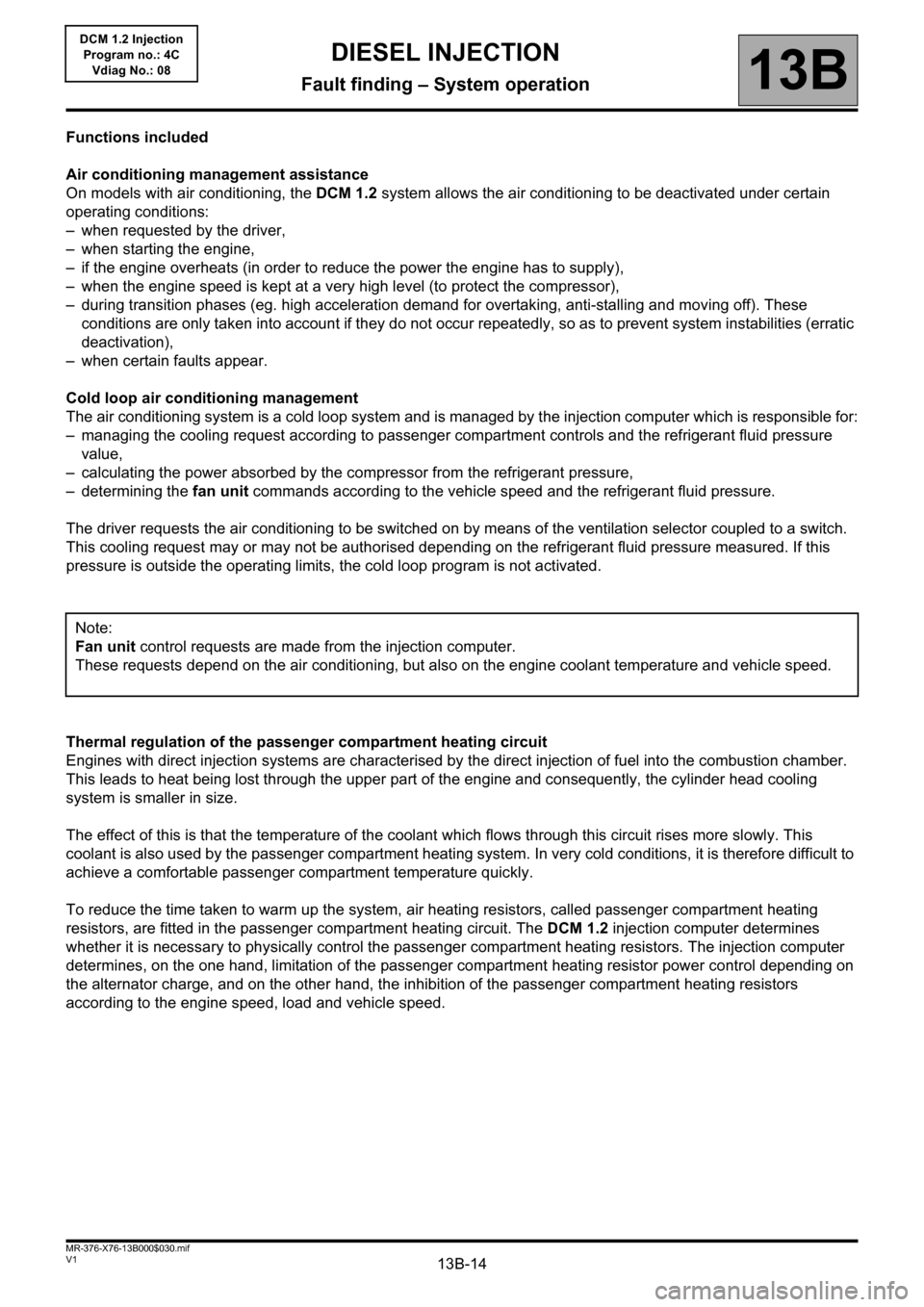
13B-14V1 MR-376-X76-13B000$030.mif
DIESEL INJECTION
Fault finding – System operation13B
DCM 1.2 Injection
Program no.: 4C
Vdiag No.: 08
Functions included
Air conditioning management assistance
On models with air conditioning, the DCM 1.2 system allows the air conditioning to be deactivated under certain
operating conditions:
– when requested by the driver,
– when starting the engine,
– if the engine overheats (in order to reduce the power the engine has to supply),
– when the engine speed is kept at a very high level (to protect the compressor),
– during transition phases (eg. high acceleration demand for overtaking, anti-stalling and moving off). These
conditions are only taken into account if they do not occur repeatedly, so as to prevent system instabilities (erratic
deactivation),
– when certain faults appear.
Cold loop air conditioning management
The air conditioning system is a cold loop system and is managed by the injection computer which is responsible for:
– managing the cooling request according to passenger compartment controls and the refrigerant fluid pressure
value,
– calculating the power absorbed by the compressor from the refrigerant pressure,
– determining the fan unit commands according to the vehicle speed and the refrigerant fluid pressure.
The driver requests the air conditioning to be switched on by means of the ventilation selector coupled to a switch.
This cooling request may or may not be authorised depending on the refrigerant fluid pressure measured. If this
pressure is outside the operating limits, the cold loop program is not activated.
Thermal regulation of the passenger compartment heating circuit
Engines with direct injection systems are characterised by the direct injection of fuel into the combustion chamber.
This leads to heat being lost through the upper part of the engine and consequently, the cylinder head cooling
system is smaller in size.
The effect of this is that the temperature of the coolant which flows through this circuit rises more slowly. This
coolant is also used by the passenger compartment heating system. In very cold conditions, it is therefore difficult to
achieve a comfortable passenger compartment temperature quickly.
To reduce the time taken to warm up the system, air heating resistors, called passenger compartment heating
resistors, are fitted in the passenger compartment heating circuit. The DCM 1.2 injection computer determines
whether it is necessary to physically control the passenger compartment heating resistors. The injection computer
determines, on the one hand, limitation of the passenger compartment heating resistor power control depending on
the alternator charge, and on the other hand, the inhibition of the passenger compartment heating resistors
according to the engine speed, load and vehicle speed.Note:
Fan unit control requests are made from the injection computer.
These requests depend on the air conditioning, but also on the engine coolant temperature and vehicle speed.
Page 15 of 204
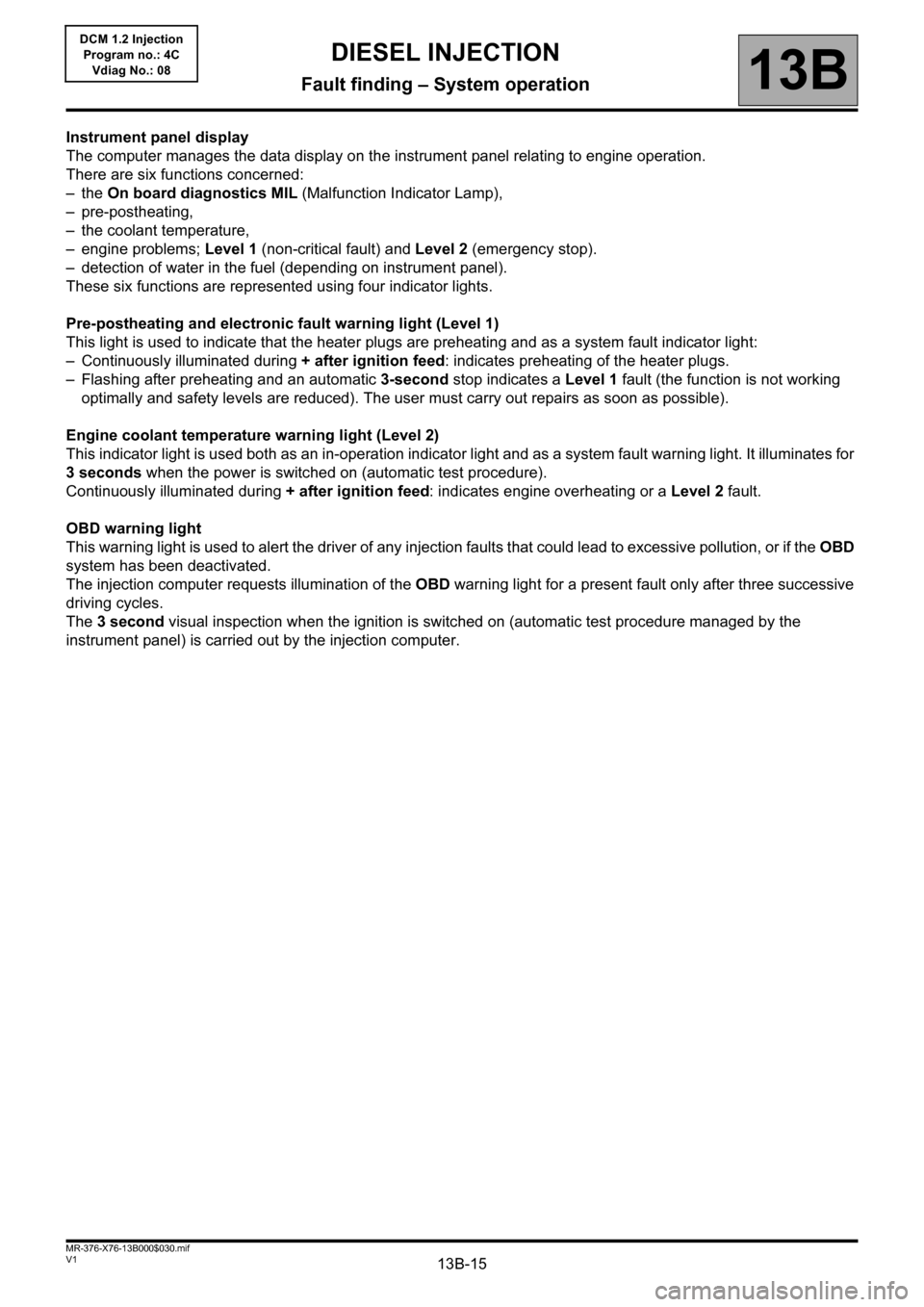
13B-15V1 MR-376-X76-13B000$030.mif
DIESEL INJECTION
Fault finding – System operation13B
DCM 1.2 Injection
Program no.: 4C
Vdiag No.: 08
Instrument panel display
The computer manages the data display on the instrument panel relating to engine operation.
There are six functions concerned:
–the On board diagnostics MIL (Malfunction Indicator Lamp),
– pre-postheating,
– the coolant temperature,
– engine problems; Level 1 (non-critical fault) and Level 2 (emergency stop).
– detection of water in the fuel (depending on instrument panel).
These six functions are represented using four indicator lights.
Pre-postheating and electronic fault warning light (Level 1)
This light is used to indicate that the heater plugs are preheating and as a system fault indicator light:
– Continuously illuminated during + after ignition feed: indicates preheating of the heater plugs.
– Flashing after preheating and an automatic 3-second stop indicates a Level 1 fault (the function is not working
optimally and safety levels are reduced). The user must carry out repairs as soon as possible).
Engine coolant temperature warning light (Level 2)
This indicator light is used both as an in-operation indicator light and as a system fault warning light. It illuminates for
3 seconds when the power is switched on (automatic test procedure).
Continuously illuminated during + after ignition feed: indicates engine overheating or a Level 2 fault.
OBD warning light
This warning light is used to alert the driver of any injection faults that could lead to excessive pollution, or if the OBD
system has been deactivated.
The injection computer requests illumination of the OBD warning light for a present fault only after three successive
driving cycles.
The 3 second visual inspection when the ignition is switched on (automatic test procedure managed by the
instrument panel) is carried out by the injection computer.
Page 16 of 204
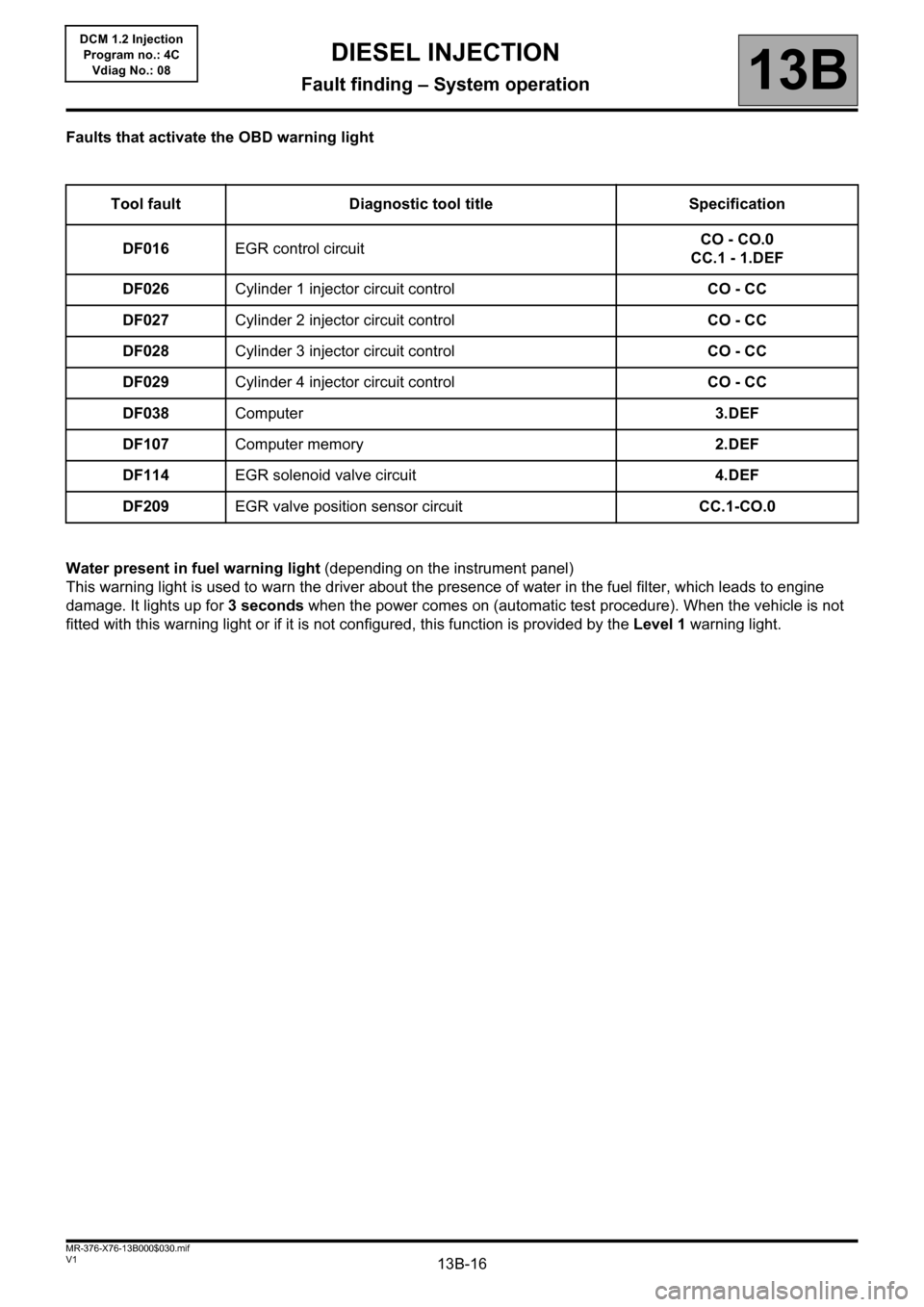
13B-16V1 MR-376-X76-13B000$030.mif
DIESEL INJECTION
Fault finding – System operation13B
DCM 1.2 Injection
Program no.: 4C
Vdiag No.: 08
Faults that activate the OBD warning light
Water present in fuel warning light (depending on the instrument panel)
This warning light is used to warn the driver about the presence of water in the fuel filter, which leads to engine
damage. It lights up for 3 seconds when the power comes on (automatic test procedure). When the vehicle is not
fitted with this warning light or if it is not configured, this function is provided by the Level 1 warning light. Tool fault Diagnostic tool title Specification
DF016EGR control circuitCO - CO.0
CC.1 - 1.DEF
DF026Cylinder 1 injector circuit controlCO - CC
DF027Cylinder 2 injector circuit controlCO - CC
DF028Cylinder 3 injector circuit controlCO - CC
DF029Cylinder 4 injector circuit controlCO - CC
DF038Computer3.DEF
DF107Computer memory2.DEF
DF114EGR solenoid valve circuit4.DEF
DF209EGR valve position sensor circuitCC.1-CO.0